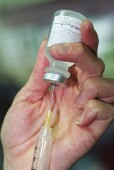
WEDNESDAY, Jan. 27 (HealthDay News) — Vaccinating infants against rotavirus could save the lives of millions of children in developing nations who would otherwise die from the diarrhea-causing disease, two new studies show.
A study conducted in Malawi and South Africa found vaccinations reduced the rate of severe, life-threatening rotavirus in infants by more than 61 percent.
A second study found deaths from diarrheal disease in Mexico fell by more than 66 percent in children 11 months and younger during the 2009 rotavirus season compared to 2003-2006. In 2006-2007, Mexico’s Ministry of Health and other major health providers made the rotavirus vaccine part of its national vaccination programs.
“A disease that may be a nuisance in the U.S. can be a killer in a poorer country,” said Dr. Kathleen Neuzil, senior author of the African study and a senior advisor for immunization at PATH, an international non-profit organization that seeks to bring affordable health care to all. “Death from diarrheal disease in general is the second-leading cause of death among kids in developing nations.”
The studies are published in the Jan. 28 issue of the New England Journal of Medicine.
More than half a million children die each year from rotavirus infection, according to the World Health Organization (WHO). Nearly half of those deaths occur in sub-Saharan Africa. Though there are many gastrointestinal diseases that can cause life-threatening diarrhea, rotavirus is among the most common. Among children hospitalized for severe diarrhea, rotavirus is the culprit in about 40 percent of cases globally, according to background information in the study.
Rotavirus is also common in the United States, with most children having a bout of it before 3 years of age, Neuzil said. But few American children die, largely because of better access to medical care and treatments such as oral rehydration — a mixture of water and electrolytes.
The U.S. Centers for Disease Control and Prevention’s Advisory Committee on Immunization Practices recommends that American children receive the rotavirus vaccine at 2, 4 and 6 months of age.
But before the WHO’s Strategic Advisory Group of Experts on Immunization would recommend vaccinating children in developing nations, it wanted to see research that showed the vaccines would be effective in poorer nations, Neuzil said.
Both of the rotavirus vaccines available are live oral vaccine. Prior research on other live oral vaccines, including polio and cholera, has shown they don’t work as well among very low-income populations. The reasons are unclear, but some suspect poorer nutrition or higher rates of the disease in those countries mean that children may already have some antibodies to the virus, perhaps through breast milk, so the vaccine may not fully “take,” Neuzil said.
Prior to publication of the new studies, the results were shared with WHO, which has since recommended the rotavirus vaccine for infants in developing nations, with the first dose being given between 6 and 15 weeks of age.
The WHO’s recommendation is critical, Neuzil said, not only for influencing health-policy decisions, but for starting the flow of aid and philanthropic dollars to pay for rotavirus vaccination programs.
In the study in Africa, researchers divided nearly 5,000 infants from Malawi and South Africa into three groups: one-third received three doses of the vaccine, one-third received two doses and one-third received a placebo. Researchers then followed-up with weekly home visits and took stool samples to confirm suspected rotavirus infections.
Children who had received either the three-dose or the two-dose regimen were 61 percent less likely to develop severe rotavirus infection. In Malawi, the effectiveness was 49 percent, compared to about 77 percent in South Africa.
In the study in Mexico, the effect was no less dramatic. During the 2009 rotavirus season, deaths among infants 11 months old and younger fell 66 percent.
In 2003-2006, about 1,793 children under age 5 died from diarrhea-related diseases each year in Mexico. In 2008, that dropped to 1,118, or nearly a 35 percent reduction. Among children between ages 1 and 2 years, deaths fell by about 29 percent in 2008, even though only 10 percent to 15 percent of the population was eligible for vaccination.
In an accompanying editorial, Dr. Mathuram Santosham, a professor of international health and pediatrics at Johns Hopkins University Bloomberg School of Public Health, said the studies provide powerful evidence for instituting rotavirus vaccination programs in developing nations throughout the world.
Malawi, South Africa and Mexico are countries with very different socio-economic patterns, Santosham said, with Malawi among the poorest in the world and South Africa relatively more affluent.
“The data from Mexico is representative of data that one would expect from Latin American countries,” he said. “Therefore, I believe that these data can be extrapolated to the majority of developing countries.”
Still, there are challenges. To protect children, WHO recommends infants receive the first dose between 6 and 15 weeks. In poorer nations, adherence to those guidelines can be spotty.
“Rotavirus vaccine is a very powerful tool to combat one of the leading causes of childhood deaths — diarrhea,” Santosham said. “The challenge now is to make sure that every poor child in the world has access to this life-saving intervention.”
In a related study from the same journal, researchers cautioned that vaccinating immune-compromised children may make them sick. But the illness is likely to be mild even in children who are HIV-positive, Santosham said in his editorial.
More information
The World Health Organization has more on rotavirus vaccine.

